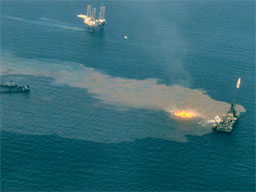ATYRAU (OSCE press service) – The Organization for Security and Cooperation in Europe (OSCE) in coordination with the Kazakh Energy Minister and the U.S. Embassy in Kazakhstan organized a discussion on how best to plan a regional response to an oil spill program. The OSCE said the event was part of a long-term effort to support an effective risk management sector in Kazakhstan.

- IXTOC I oil well blowout
After the platform Sedco 135 burns and sinks in the Bay of Campeche, Mexico. Located in the Gulf of Mexico.
(Credit: NOAA)
The roundtable brought more than 60 representatives together in Astana to follow up on talks first launched in 2003 by oil investors in the region. Participants endorsed what the OSCE described as a draft template on oil spill response in the region. Parties to the talk said they took special note of the oil spill in the Gulf of Mexico in 2010.
The event was organized by the OSCE Programme Office in Astana in close co-operation with the Energy Ministry, the Oil Spills Preparedness Initiative for Caspian Sea, Black Sea and Central Eurasia (OSPRI), launched in 2003 by all major oil industry investors in the region, and the US Embassy in Kazakhstan.
The OSPRI manager, Peter Taylor, said: “Once approved, the regional oil spill plan will be an important tool to ensure that the regional authorities have a system that will ensure effective co-ordination and integration of all relevant resources both from government and private sectors. A critical first step in the plan’s implementation will be the convening of the standing Working Group on oil spill preparedness and response in support of the existing Commission on Emergencies at the regional level, which will keep the plan updated and relevant.”
The roundtable also facilitated the exchange of international expertise, available best practices and experience in combating consequences of oil spills in various parts of the world, most notably in the Gulf of Mexico in 2010.
Kazakhstan’s government in February said it expects oil production to increase by as much as 30% in part because of operations at its giant Kashagan field. Kashagan is among the largest oil fields in the world, with an estimated 16 bln barrels of oil reserves. Production was halted in October 2013, less than a month after it started, when a pipeline associated with the field cracked open. A resumption of operations is expected next year.

